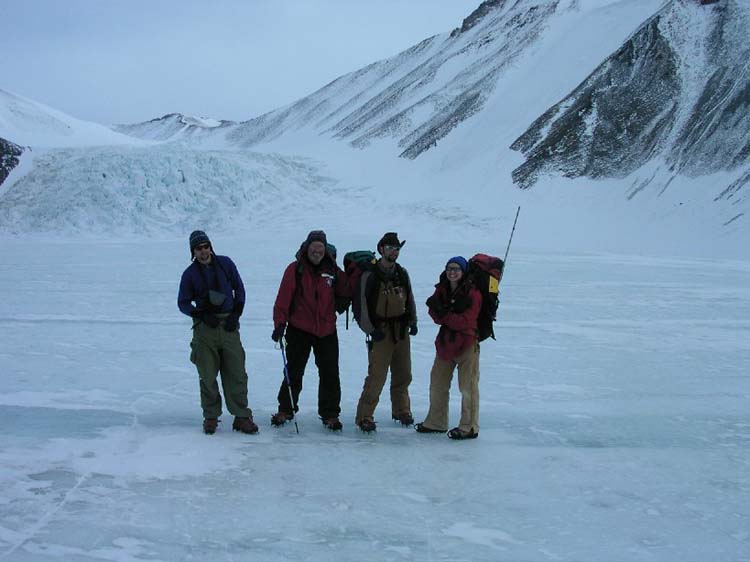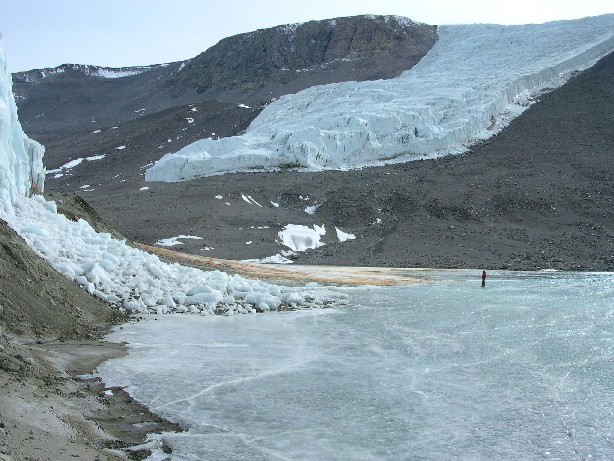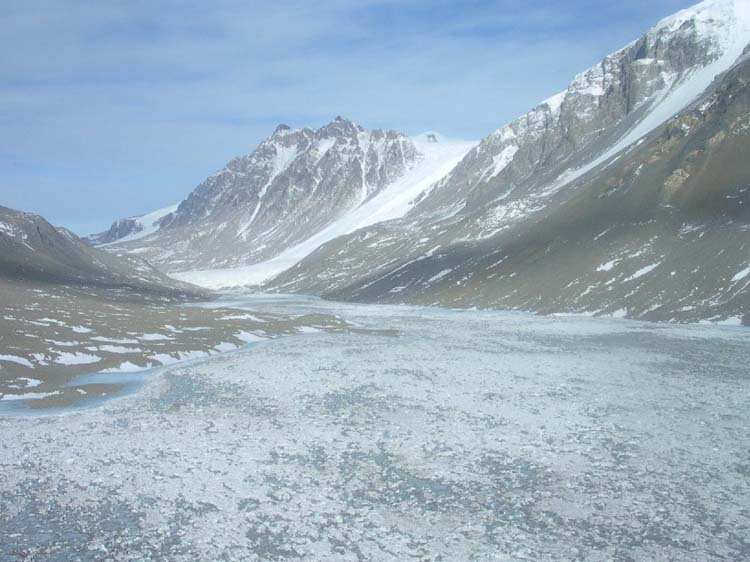Home|Glossary|Links|Journal|Maps
Introducing
the Stream team 2003-2004

From left to right
– Chris, Ben, Justin, and Karen hike over Canada
Glacier on their way to the Lake Hoare base camp for Thanksgiving.
DIANE
MCKNIGHT
Dr.
Diane McKnight is the head of the Dry Valleys' Stream Team. An Antarctic
veteran, she's been going down "to the ice" since 1987.
Early in her career, Diane worked as a research scientist with the
United States Geological Survey.
|
Now
she's a professor in the Department of Civil and Environmental
Engineering at the University of Colorado-Boulder (CU), and
a member of CU's Institute of Arctic and Alpine Research or
INSTAAR. In addition to her teaching duties, Diane serves on
Columbia River and Neuse River committees. She's also a mom.
Diane loves to travel and between her research projects and
those of her students, she's involved in work in the U.S., the
Arctic, and Africa, as well as in Antarctica. So she gets around!
Yet even with all this going on, Diane still manages to find
time to quilt. Diane's also known for baking incredibly yummy
pies. Since coming to the field she's already baked four of
them! We're hoping she doesn't stop any time soon.
|

Diane filters water during a tracer experiment
|
CHRIS JAROS (leftmost person
in team photo)
Stream Teamer Chris Jaros has headed down to the ice for his third season.
Chris's first season, 2000-2001, was the coldest since the McMurdo Dry
Valleys Long-Term Ecological Research project (MCMLTER) began while
his second, 2001-2002, is known in MCMLTER circles as "the flood
year."
|

Chris stands
next to Taylor Glacier.
The Rhone Glacier descends in the background.
|
The
normally small moats that develop along the edges of the ice covering
Dry Valley lakes became large enough for crossing to be, as Chris
puts it "a little sketchy." And Chris and the rest of
the team had to deal with several stream gages being blown out
and flows that were double those recorded for previous seasons.
We've now had a week of above-freezing temperatures. The streams
have really started to flow, and Chris is officially calling it.
He thinks it's going to be a big year. Probably not a "flood"
year but high flowsnonetheless.
A native of Grand Junction, Colorado,
Chris just finished his master's degree in environmental engineering
(Congrats Chris!). Dr. Diane McKnight (who is coming down a
little later in the season) was his advisor, and his research
focused on the effects of elevation on glacial meltwater generation
in the Dry Valleys.
|
In his free time Chris enjoys putting
some serious miles on his bike and fly fishing in Colorado's mountain
streams. He also likes to stomp around the hut of our base camp, bang
things, and just make a lot of noise. That's earned him the nickname
of the Flintstone's character Bam-Bam.
BEN HARDING
(second person from left in team photo)
Ben is a civil engineer who's worked in a variety of capacities during
his career. His current stint with hydrosphere has lasted some 20
years. Hydrosphere, a Boulder, Colorado-based environmental consulting
firm
that Ben co-founded, specializes in water resource issues. Ben's present
projects include providing expert testimony about how toxic chemicals
move through water distribution systems and helping municipalities
plan how they will manage their water supplies.
Ben grew up in Boulder, and, as a youngster,
was really into skiing. Later on he became an avid kayaker. He's also
obtained his pilot's license and is qualified to fly light aircraft.
One of his favorite activities these days though is going on hikes
with his wife and two sons. Ben has been interested in going to Antarctica
for ages, not the least of which because his dad worked in Antarctica
40 years ago as an electrical/communications engineer.
Big into fixing things, Ben likes to,
in his words, kluge. Kluging, he explains, involves making a practical
"construction that is often bizarre, always necessary, and sometimes
fun." Some of the gizmos he's helped come up with will likely
show up in various Stream Team reports.
|
JUSTIN JOSLIN
(second from right in team photo)
Justin is another one of Diane's graduate students. He's working
on his master's degree in environmental engineering at CU-Boulder.
A first-timer in Antarctica, he'll be looking at how chemical
weathering affects the
chemistry of Dry Valley streams.
If you hang out with Justin for
even a short amount of time, you'll quickly realize two things.
One - he's from New Hampshire, a fact he's quite proud of, and
two - he's a total ski nut. Justin's been downhill skiing for
ages
and is currently on CU's freestyle ski team for which he specializes
in skiing moguls. During the summer, Justin's activities branch
out into hiking and rock climbing as well.
Justin likes cowboy hats. They
shade both your face and the back of your neck, he points out,
and are thus not only stylish but also useful, at least in warmer
climes. He's worn his hat in Antarctica a few times, and people
sometimes call him by his newly acquired nickname Jessie James.
|
 Justin
at Lyons Stream - one of the first streams we've seen flow in
the valleys.
Justin
at Lyons Stream - one of the first streams we've seen flow in
the valleys. |
KAREN
COZZETTO (rightmost person
in team photo)
Karen is a PhD student studying
hydrology at the University of Colorado-Boulder. This season is Karen's
second in the Dry Valleys, and she'll be looking at how soils around
streams freeze and thaw and at how stream waterwarms
up. At some times of the day, the stream temperatures can reach 50 or,
on occasion, even 60 degrees Fahrenheit!
Hailing from Washington, DC, Karen
may like to travel as much as her advisor, Diane. Karen's lived in
the Czech Republic, spent a summer in Spain and Italy, and worked
on a project in Yucatan, Mexico. She loves to hike and bike and is
always on the lookout for good chocolate.

A view of Taylor
Valley. The Suess Glacier and ice-covered Lake Hoare.





